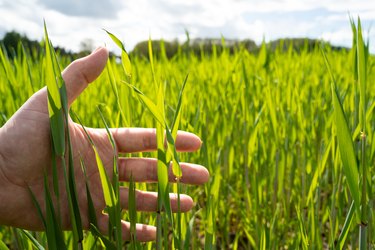
Water is essential for healthy green lawns, but too much of it can wreak havoc. When there is poor drainage, property owners can use certain kinds of grass for wet areas, as these may grow better than other varieties. It's very important to choose the right wet soil grass seed. The right kind can make all the difference and can thrive in these kinds of conditions.
Grass for Wet Areas
Video of the Day
It is extremely important to plant grasses that tolerate wetter conditions if your climate is wet. It is also essential to know what type of soil you have. If it is high in saline or alkaline, this could pose additional problems. For wet and saline/alkaline soils, it is recommended to use wildrye grasses, such as Canada wildrye (Elymus canadensis) and beardless wildrye (Leymus triticoides). Both of these grow well in USDA plant hardiness zones 3 to 5. You can also try wheatgrass (Thinopyrum intermedium) and creeping foxtail (Alopecurus arundinaceus) in zones 4 to 9.
Video of the Day
If there is poor drainage but no salinity issues, Virginia wildrye (Elymus virginicus) will grow well in zones 3 to 8. Red top (Agrostis gigantea) can grow in zone 8a to -12 degrees Fahrenheit.
Another type of grass that could thrive in zones 4 to 5 is tall fescue (Festuca arundinacea) since it does well in both wet and dry soils. It has wet soil tolerance, it is durable and it is a staple species for soil reclamation, bank stabilization and waterways.
Types of Fescue
One of the best known types of fescue is Kentucky bluegrass (Poa pratensis, which grows in USDA zone 6). Classified as a sodgrass, it spreads by short rhizomes and grows short and dense. Ryegrass (Lolium) is also a fescue and does well in cool, moist soil in zones 2 to 8. Meadow fescue (Festuca pratensis) also survives in wet soils in zones 4 to 10 but not in flooding conditions. It is good for cool Northern regions because it is winter hardy, but it does not always do well during droughts.
Festulolium (Festulolium, which grows best in zones 2 to 4) grass is a hybrid of tall fescue or meadow fescue and ryegrass. This makes it adaptable to wet soil with the added benefit of winter hardiness.
To keep the grass healthy and aid with drainage, remember to aerate the lawn once a year if you have heavy clay soil or high-traffic areas. Otherwise, you can do this once every two or three years. Top-dressing can also help with water absorption, but this should only be done during the late spring or summer. One word of warning: Never use sand for top-dressing. Compost or other materials more beneficial for the soil are recommended.
Other Ways to Improve Drainage
If you are not ready to reseed your entire lawn, you can try to improve drainage problems in other ways. Installing an exterior sump pump can help pull out moisture. These take the unwanted rainwater and drain it to locations that are uphill from the property. These are pretty expensive to buy and run, though.
Another option is a curtain drain or French drain, but these can only be used when the property is at a lower elevation than the surrounding land. These are made with perforated pipes dug into the ground, which run from the poorly draining areas to safe zones. The holes in these pipes draw in water, and gravity does the rest.
A last choice is to install a drywell. These containers have tanks that accumulate and store the excess runoff. Once they fill, the water drains into the well and the soil around the well. Drywells are made from porous materials and can be installed in the ground and covered, so you won't have to see them.